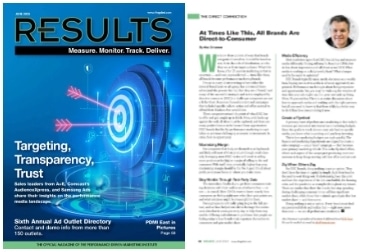By Alex Dinsmoor
The Direct Connection
We know there are lots of ways that brands categorize themselves. It could be based on size, their channels of distribution, or who they see as their target audience. What I do know, after 25 years in marketing, is that in uncertain — and even unprecedented — times like these, all brands become performance marketing brands.
I’ve sat in many client meetings where either the internal brand team or ad agency has convinced themselves (and the powers that be) that they are a “brand,” and many of the successful strategies and tactics employed by direct-to-consumer (D2C) or challenger companies are not a fit for them. Response-focused content and campaigns that included specific calls-to-action and offers seemed to offend their Madison Ave. sensibilities.
These companies missed the point of what D2C has to offer and got caught up in labels. Now, with backs up against the wall, all ideas must be explored, and there are many positive lessons to be learned from opportunistic D2C brands that live by performance marketing to capitalize on previous challenging economic environments. In crisis, there is opportunity.
Maximizing Margin
For companies that truly see themselves as big brands and likely sell most of their product through retail channels, leveraging more D2C tactics will result in selling more product at the higher margin of selling to the end consumer. With tariff rates potentially higher than ever, maximizing margin should be the No. 1 goal. It’s all about profit, so increase focus on where you make more.
Stay Nimble Through First-Party Data
The immediate feedback you get from consumers making decisions with their wallets on whether to buy — or not — is crucial. Most CMOs want to know exactly how consumers are feeling right now, what their pain points are, and what solutions might be meaningful to them.
Focus groups are not really going to give the full picture, and we have helped our clients leverage the continuous data that is coming in every day to help them stay nimble. Offering real solutions to problems that people are feeling today is how brands truly ingratiate themselves to consumers and gain market share.
Media Efficiency
Most marketers agree that D2C brands buy and measure media differently. Pricing still may be based on CPMs, but its less about impressions and all about actual ROI. What media is working on a daily/weekly basis? What changes need to be made to optimize?
D2C brands typically make media decisions on a weekly basis, buying one-to-two weeks in advance, aggressively negotiated. Performance marketing is about being responsive and opportunistic. Yes, you may be widening the window of time that your ads might run, but your cost ends up being 50-to-70-percent less. There is an entire discussion about how to approach media and working with the right partners, but all you need to know is that there is likely a better way to do it than how you are doing it now.
Create a Flywheel
A primary tenet of performance marketing is that today’s revenues get reinvested into tomorrow’s marketing budgets. Since the goal is to track almost every sale back to specific media, you know what is working and you keep investing.
This is how marketing budgets can scale quickly. The finance and marketing departments are aligned to create a sales campaign — yes, a “sales” campaign — that becomes your primary marketing vehicle. This is the flywheel effect, where each aspect of the campaign is producing more momentum to keep things moving with less effort and net cost.
Zig When Others Zag
For D2C brands, doing nothing is not an option. They don’t have the time or capital to simply duck their head in the sand to wait things out. Unfortunately, I see this a lot and have the experience of the dot.com bubble, the housing crisis, and the pandemic as examples throughout my tenure. There are studies that show the brands that stop spending during challenging economic times will lose significant market share, while those that maintain spend gain that lost market share — and then some.
Doing nothing is not an option. Every brand must shed any perceived labels and realize that — right now, more than ever — we are all performance marketers.


